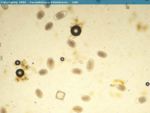Difference between revisions of "Moniezia"
Jump to navigation
Jump to search
m |
|||
| Line 1: | Line 1: | ||
| − | |||
{{toplink | {{toplink | ||
|backcolour = | |backcolour = | ||
| Line 11: | Line 10: | ||
== ''Moniezia'' Species == | == ''Moniezia'' Species == | ||
| + | [[Image:Moniezia ruminant.jpg|thumb|right|150px|''Moniezia'' ruminant - Joaquim Castellà Veterinary Parasitology Universitat Autònoma de Barcelona]] | ||
| + | [[Image:Moniezia ruminant 2.jpg|thumb|right|150px|''Moniezia'' ruminant - Joaquim Castellà Veterinary Parasitology Universitat Autònoma de Barcelona]] | ||
*Different species occur in sheep and cattle. | *Different species occur in sheep and cattle. | ||
*In the UK, Monieza is very common in lambs but rarely seen in cattle. | *In the UK, Monieza is very common in lambs but rarely seen in cattle. | ||
Revision as of 14:37, 22 December 2008
|
|
Moniezia Species
- Different species occur in sheep and cattle.
- In the UK, Monieza is very common in lambs but rarely seen in cattle.
- It has a typical tapeworm appearance and is some 2m long.
- The segments are wider than they are long.
- Although impressive when found in a lamb at post mortem examination, Monieza is of little, if any, clinical significance.
- Some believe that it may sometimes slow growth rates, but this has not been proven under British conditions.
- Farmers become aware of infection in late summer when spontaneous expulsion often occurs. Lengths of strobila may then be seen hanging from the back-end of lambs.
- The eggs are similar in appearance to those of A. perfoliata.
- Pasture mites act as intermediate hosts.

